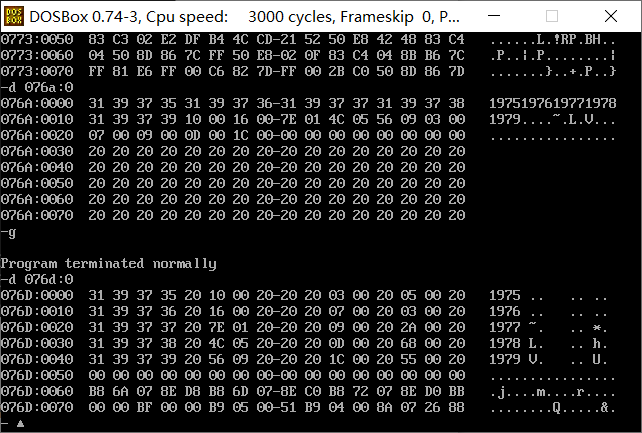Experiment task 1:
Task 1-1
task1_1.asm source code task1_1 screenshot before the end of line17 and line19
assume ds:data, cs:code, ss:stack data segment db 16 dup(0) data ends stack segment db 16 dup(0) stack ends code segment start: mov ax, data mov ds, ax mov ax, stack mov ss, ax mov sp, 16 mov ah, 4ch int 21h code ends end start
Screenshot:
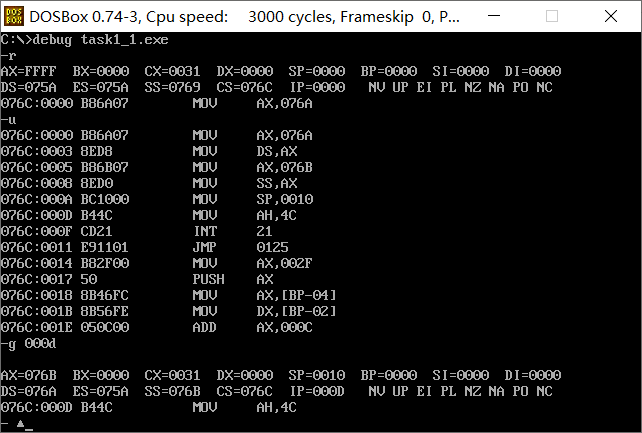
Question answer ① in debug, execute until the end of line17 and before line19, and record this time: register (DS) =__ 076A__, Register (SS) =__ 076B__, Register (CS) =__ 076C__
② Assuming that the segment address of the code segment is X after the program is loaded, the segment address of the data segment is X_ X-2___, The segment address of stack is_ X-1___.
Task 1-2
Task task1_2.asm source code task1_2. After debugging to the end of line17 and before line19, observe the screenshot of register DS, CS and SS values
; ex2.asm assume cs:code code segment mov ax, 0b810h mov ds, ax mov bx, 0 mov ax, 101H mov cx, 4 s: mov [bx], ax add bx, 2 add ax, 101H loop s mov ah, 4ch int 21h code ends end
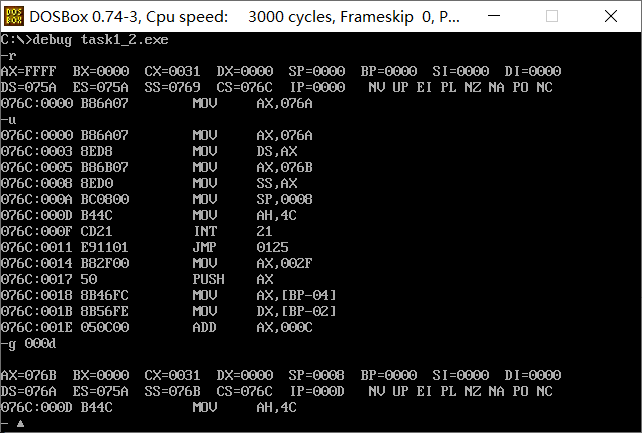
Answer to question ① in debug, execute until the end of line17 and before line19, and record this time: register (DS) = 076A__, Register (SS) =_ 076B___, Register (CS) = 076C____
② Assuming that the segment address of the code segment is X after the program is loaded, the segment address of the data segment is X__ X-2__, The segment address of stack is_ X-1___.
Task 1-3
Task task1_3.asm source code task1_3. Screenshot of the values of registers DS, CS and SS before the end of debugging to line17 and line19
assume ds:data, cs:code, ss:stack data segment db 20 dup(0) data ends stack segment db 20 dup(0) stack ends code segment start: mov ax, data mov ds, ax mov ax, stack mov ss, ax mov sp, 20 mov ah, 4ch int 21h code ends end start
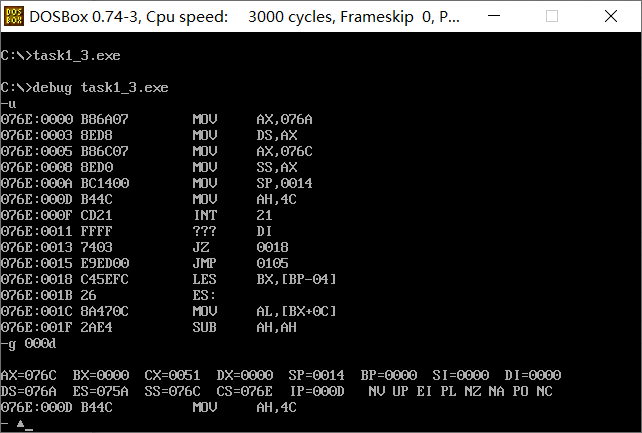
Question answer ① in debug, execute until the end of line17 and before line19, and record this time: register (DS) =_ 076A___, Register (SS) =_ 076C___, Register (CS) = 076E____
② Assuming that the segment address of the code segment is X after the program is loaded, the segment address of the data segment is X__ X-4__, The segment address of stack is_ X-2___.
Task task1_4.asm source code task1_4. After debugging to the end of line17 and before line19, observe the screenshot of register DS, CS and SS values
assume ds:data, cs:code, ss:stack code segment start: mov ax, data mov ds, ax mov ax, stack mov ss, ax mov sp, 20 mov ah, 4ch int 21h code ends data segment db 20 dup(0) data ends stack segment db 20 dup(0) stack ends end start
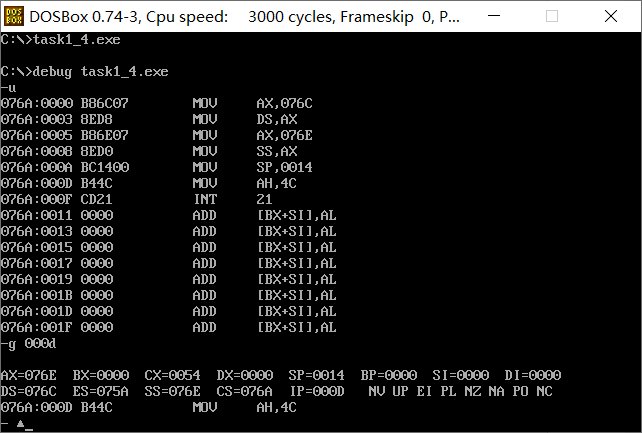
Question answer ① in debug, execute until the end of line9 and before line11, and record this time: register (DS) =_ 076C___, Register (SS) =_ 076E___, Register (CS) = 076A____
② Suppose that after the program is loaded, the segment address of the code segment is x__, Then, the segment address of the data segment is_ X+2___, The segment address of stack is_ X+4___.
Tasks 1-5
Based on the practice and observation of the above four experimental tasks, summarize and answer:
① For the segment defined below, after the program is loaded, the actual memory space allocated to the segment is_ (N/16+1)*16___.
xxx segment db N dup(0) xxx ends
② If the pseudo instruction end start in the programs task1_1.asm, task1_2.asm, task1_3.asm and task1_4.asm is changed to end, which program can still be executed correctly. Combined with the conclusions obtained from practical observation, analyze and explain the reasons.
task1_4.asm can be executed. Because this file starts with a program segment and none of the others is, it cannot be executed normally.
Experimental task 2
Assembly source code
assume cs:code 3 4 code segment 5 start: 6 mov ax,0b800h 7 mov ds,ax 8 mov bx,0f00h 9 mov cx,80 10 11 s: mov [bx],0403h 12 add bx,2 13 loop s 14 15 mov ah, 4ch 16 int 21h 17 code ends 18 end start
Screenshot of operation results
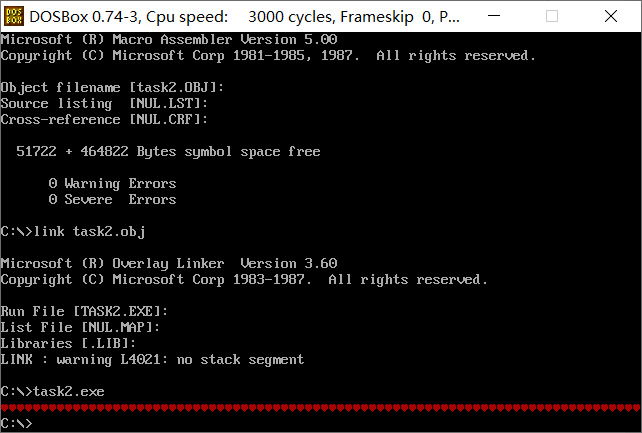
Experimental task 3
Complete assembly source code
assume cs:code data1 segment db 50, 48, 50, 50, 0, 48, 49, 0, 48, 49 ; ten numbers data1 ends data2 segment db 0, 0, 0, 0, 47, 0, 0, 47, 0, 0 ; ten numbers data2 ends data3 segment db 16 dup(0) data3 ends code segment start: ;hold asg Put your data in csg in mov ax,data1 ;data1 Address on ax in mov dx,data3 ;data3 Address on dx in mov ds,ax ;data1 Address on ds in mov ss,dx ;data3 Address on ss in mov bx,0 ;Offset address mov cx,8 ;Cycle 8 times s1: mov al,ds:[bx] ;hold data1 Copy data to al in mov ss:[bx],al ;hold al Copy data to data3 in inc bx ;deviation++ loop s1 ;hold data2 Data added to data3 in mov ax,data2 ;data2 Address on ax in mov ds,ax ;data2 Address on ds in mov bx,0 ;Control offset address mov cx,8 ;Cycle 8 times s2: mov al,ds:[bx] ;hold data2 Copy data to al in mov ah,0h ;High complement 0 mov dl,ss:[bx] ;hold data3 Copy data to dl in mov dh,0h ;High complement 0 add ax,dx ;hold dx Data plus ax Data exists ax in mov ss:[bx],al ;hold al Copy data to data3 in inc bx loop s2 mov ah, 4ch int 21h code ends end start
Load, disassemble and debug screenshots in debug
It is required to give the debug command and screenshot to view the original value of memory space data corresponding to logical segments data1, data2 and data3 before adding data items in turn

And, after adding in turn, view the debug command and screenshot of the original value of memory space data corresponding to logical segments data1, data2 and data3

Experimental task 4
Complete assembly source code
assume cs:code data1 segment dw 2, 0, 4, 9, 2, 0, 1, 9 data1 ends data2 segment dw 8 dup(?) data2 ends stack segment db 16 dup(0) stack ends code segment start: mov ax, data1 mov ds, ax mov ax, data2 mov ss, ax ; mov sp, 10h ; mov bx, 0 mov cx, 8 s: push [bx] add bx, 2 loop s mov ah, 4ch int 21h code ends end start
Load, disassemble and debug screenshots in debug
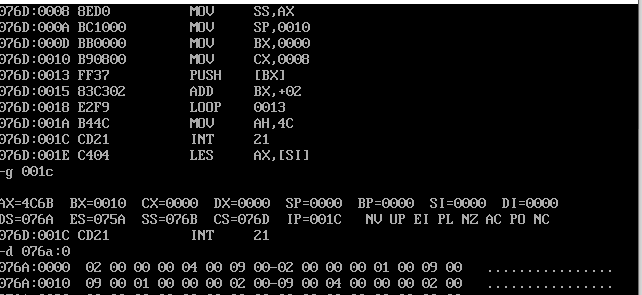
It is required to give a screenshot of the memory space corresponding to data segment data2 by using the d command before the program exits.
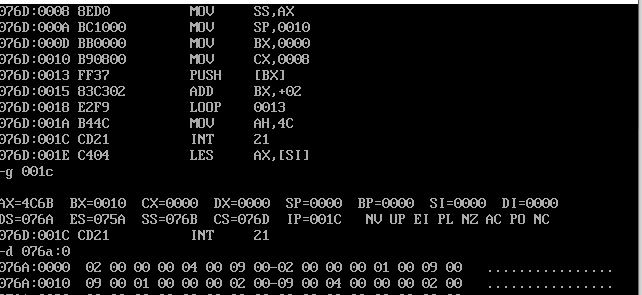
Experimental task 5
task5.asm source code
assume cs:code, ds:data data segment db 'Nuist' db 2, 3, 4, 5, 6 data ends code segment start: mov ax, data mov ds, ax mov ax, 0b800H mov es, ax mov cx, 5 mov si, 0 mov di, 0f00h s: mov al, [si] and al, 0dfh mov es:[di], al mov al, [5+si] mov es:[di+1], al inc si add di, 2 loop s mov ah, 4ch int 21h code ends end start
Screenshot of operation results
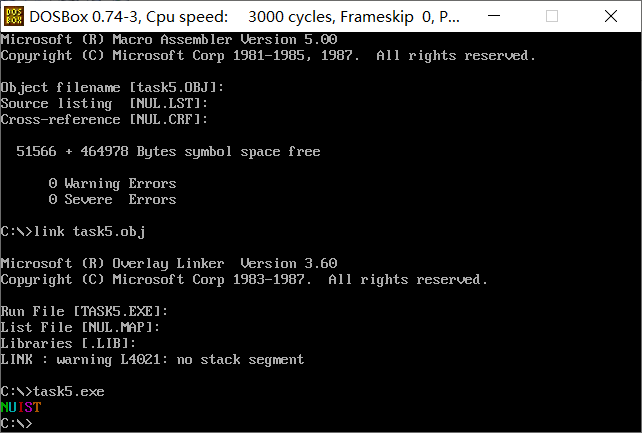
Use the debug tool to debug the program, and use the g command to execute the screenshot before the program returns (i.e. after ine25 and before line27)
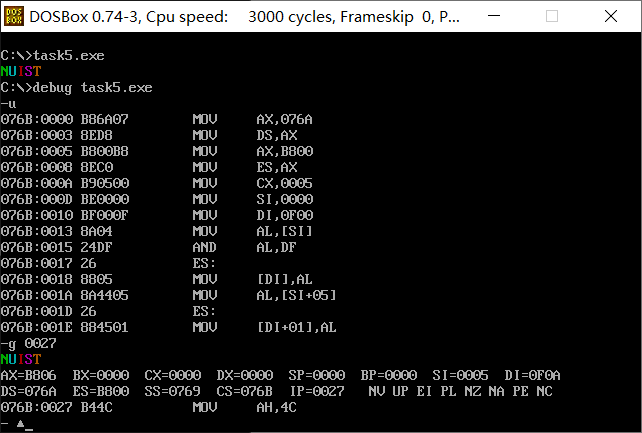
What is the function of line19 in the source code?
Change lowercase letters to uppercase letters
What is the purpose of the byte data in the data segment line4 in the source code?
Set color
Experimental task 6
task6.asm source code
assume cs:code, ds:data data segment db 'Pink Floyd ' db 'JOAN Baez ' db 'NEIL Young ' db 'Joan Lennon ' data ends code segment start: mov ax,data mov ds,ax mov cx,4 mov bx,0 s: mov dx,cx mov cx,4 mov si,0 p: mov al,ds:[bx+si] or al,00100000B mov ds:[bx+si],al inc si loop p add bx,16 mov cx,dx; loop s mov ah, 4ch int 21h code ends end start
Load, disassemble and debug screenshots in debug
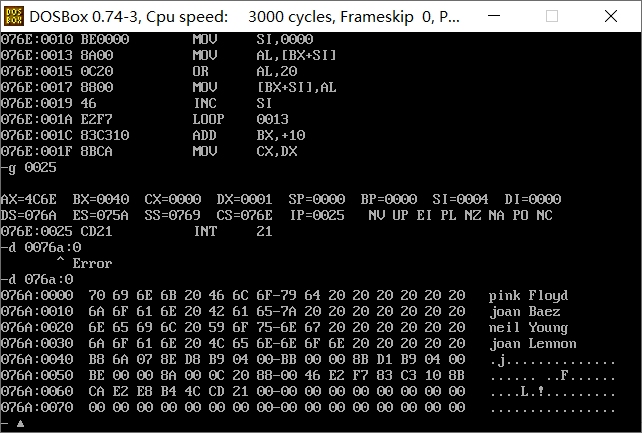
It is required to give a screenshot of the memory space corresponding to the data segment data by using the d command before the program exits.
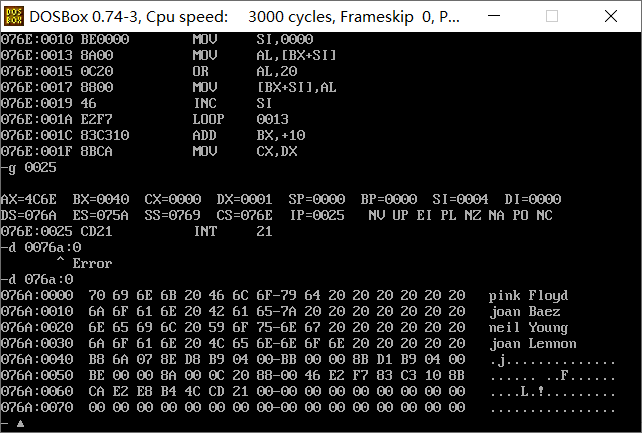
Experimental task 7
Screenshot of task7.asm source code debugging
assume cs:code, ds:data, es:table data segment db '1975', '1976', '1977', '1978', '1979' dw 16, 22, 382, 1356, 2390 dw 3, 7, 9, 13, 28 data ends table segment db 5 dup( 16 dup(' ') ) ; table ends stack segment db 16 dup(?) stack ends code segment start: mov ax, data mov ds, ax mov ax, table mov es, ax mov ax, stack mov ss, ax mov bx, 0 mov di, 0 mov cx, 5 s1: push cx mov cx, 4 s2: mov al, [bx] mov es:[di], al inc bx inc di loop s2 add di, 12 pop cx loop s1 mov di, 0 mov bx, 0 mov cx, 5 s3: mov ax, [20 + bx] mov es:[di + 5], ax mov dl, [30 + bx] div dl mov ah, 0 mov es:[di + 13], ax mov ax, [30 + bx] mov es:[di + 10], ax add di, 10h add bx, 2 loop s3 mov ah, 4ch int 21h code ends end start
View screenshot of original data information of table segment
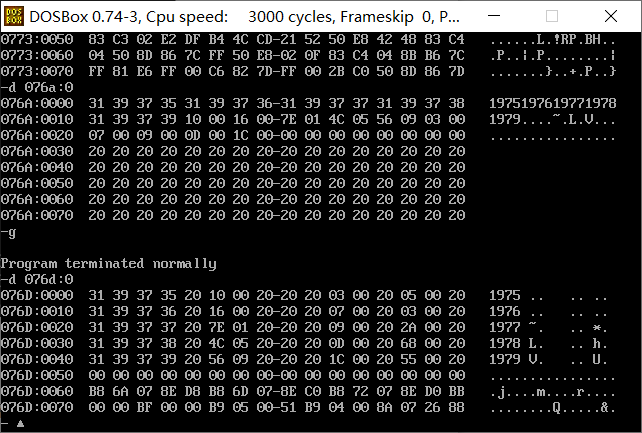
Run in debug until the program exits, use the d command to view the screenshot of the memory space corresponding to the table segment, and confirm whether the information is structurally written to the specified memory as required
